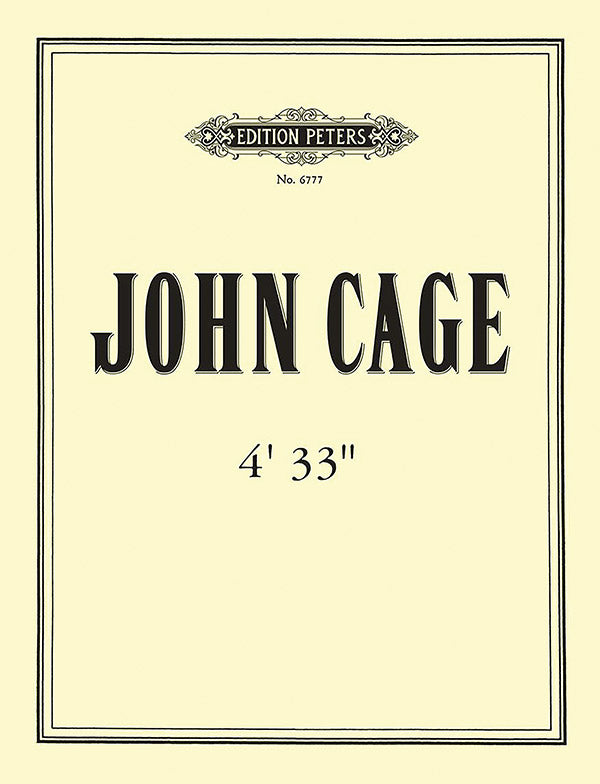Cage: 4'33"
In stock and typically ships within 1 business day.
- Composer: John Cage (1912-1992)
- Instrumentation: Any Instrument
- Work: 4' 33" (1952)
- ISMN:
- Size: 9.2 x 11.9 inches
- Pages: 4
Description
For all its apparent simplicity John Cage's seminal 4'33'' ('Four, Thirty-Three') continues to stimulate, provoke, enrage and delight audiences nearly 70 years after it was composed.
The premiere of the three-movement 4'33'' was given by David Tudor on August 29, 1952, at Woodstock, New York as part of a recital of contemporary piano music. The audience saw him sit at the piano and, to mark the beginning of the piece, close the keyboard lid. Some time later he opened it briefly, to mark the end of the first movement. This process was repeated for the second and third movements. The piece had passed without a note being played--in fact without Tudor (or anyone else) having made any deliberate sound as part of the piece. Tudor timed the three movements with a stopwatch while turning the pages of the score.
"They missed the point. There's no such thing as silence. What they thought was silence, because they didn't know how to listen, was full of accidental sounds. You could hear the wind stirring outside during the first movement. During the second, raindrops began patterning the roof, and during the third the people themselves made all kinds of interesting sounds as they talked or walked out." John Cage speaking about the premiere of 4'33"
Several versions of the score for 4'33" exist, including:
The Kremen manuscript (1953): graphic, space-time notation, dedicated to Irwin Kremen The movements of the piece are rendered as space between long vertical lines; a tempo indication is provided (60), and at the end of each movement the time is indicated in minutes and seconds EP No. 6777a.
The so-called First Tacet Edition: a typewritten score, lists the three movements using Roman numbers, with the word "TACET" underneath each. A note by Cage describes the first performance and mentions that "the work may be performed by (any) instrumentalist or combination of instrumentalists and last any length of time."
This present edition is the so-called Second Tacet Edition : this is the same as the First Tacet Edition, except that it is printed in Cage's calligraphy, and the explanatory note mentions the Kremen manuscript.
Publishers use a lot of words to describe what they sell, and we know it can be confusing. We've tried to be as clear as possible to make sure you get exactly what you are looking for. Below are descriptions of the terms that we use to describe the various formats that music often comes in.
Choral Score
A score for vocalists that only contains the vocal lines. The instrumental parts are not there for reference. Generally, cheaper than a vocal score and requires multiple copies for purchase.
Facsimile
Reproductions of the original hand-written scores from the composer.
Full Score
For ensemble music, this indicates that the edition contains all parts on a single system (there are not separate parts for each player). In larger ensembles, this is for the conductor.
Hardcover
Hardbound. Generally either linen-covered or half-leather.
Orchestral Parts
Similar to a wind set, this is a collection of parts. In the case of strings, the numbers listed are the number of copies included, though generally these are available individually (often with minimum quantities required).
Paperback
When publishers offer multiple bindings (e.g. hardcover) or study scores, this is the "standard" version. If you're planning to play the music, this is probably what you want.
Performance / Playing Score
A score of the music containing all parts on one system, intended for players to share. There are not separate parts for each player.
Set of Parts
For ensemble music, this indicates that there are separate individual parts for each player.
Solo Part with Piano Reduction
For solo pieces with orchestra, this is a version that contains a piano reduction of the orchestra parts. For piano pieces, two copies are typically needed for performance.
Study Score
A small (think choral size) copy of the complete score meant for studying, and not playing. They make great add-ons when learning concertos and small chamber works.
Vocal Score
A score prepared for vocalists that includes the piano/organ part or a reduction of the instrumental parts.
Wind Set
For orchestral music, this is a collection of wind and percussion parts. The specific quantities of each instrument are notated.
With Audio
In addition to the printed music, the edition contains recordings of the pieces. This may be an included CD, or access to files on the internet.
With / Without Fingering (Markings)
Some publishers prepare two copies - a pure Urtext edition that includes no fingering (or bowing) suggestions and a lightly edited version that includes a minimal number of editorial markings.


